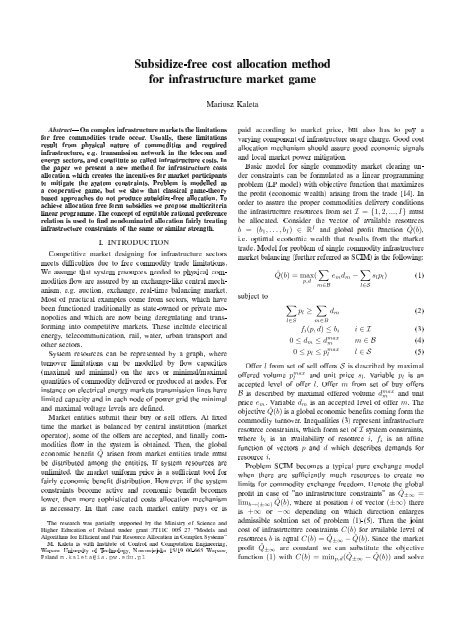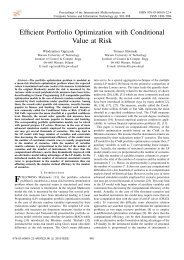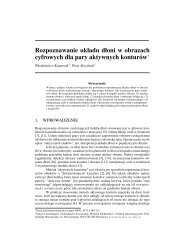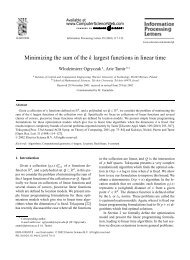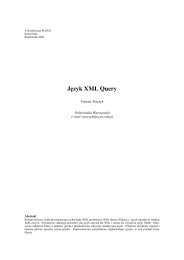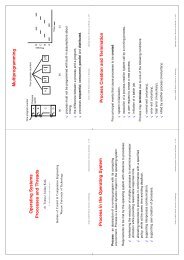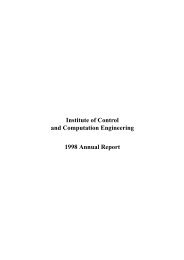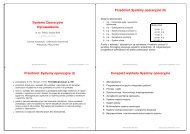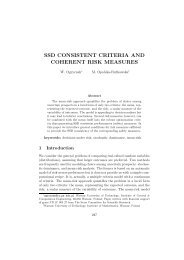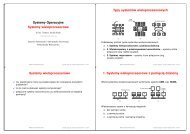Subsidize-free cost allocation method for infrastructure ... - Ozyrys
Subsidize-free cost allocation method for infrastructure ... - Ozyrys
Subsidize-free cost allocation method for infrastructure ... - Ozyrys
You also want an ePaper? Increase the reach of your titles
YUMPU automatically turns print PDFs into web optimized ePapers that Google loves.
<strong>Subsidize</strong>-<strong>free</strong> <strong>cost</strong> <strong>allocation</strong> <strong>method</strong><br />
<strong>for</strong> <strong>infrastructure</strong> market game<br />
Mariusz Kaleta<br />
Abstract—On complex <strong>infrastructure</strong> markets the limitations<br />
<strong>for</strong> <strong>free</strong> commodities trade occur. Usually, these limitations<br />
result from physical nature of commodities and required<br />
<strong>infrastructure</strong>, e.g. transmission network in the telecom and<br />
energy sectors, and constitute so called <strong>infrastructure</strong> <strong>cost</strong>s. In<br />
the paper we present a new <strong>method</strong> <strong>for</strong> <strong>infrastructure</strong> <strong>cost</strong>s<br />
<strong>allocation</strong> which creates the incentives <strong>for</strong> market participants<br />
to mitigate the system constraints. Problem is modelled as<br />
a cooperative game, but we show that classical game-theory<br />
based approaches do not produce subsidize-<strong>free</strong> <strong>allocation</strong>. To<br />
achieve <strong>allocation</strong> <strong>free</strong> <strong>for</strong>m subsidies we propose multicriteria<br />
linear programme. The concept of equitable rational preference<br />
relation is used to nd nondominated <strong>allocation</strong> fairly treating<br />
<strong>infrastructure</strong> constraints of the same or similar strength.<br />
I. INTRODUCTION<br />
Competitive market designing <strong>for</strong> <strong>infrastructure</strong> sectors<br />
meets difculties due to <strong>free</strong> commodity trade limitations.<br />
We assume that system resources needed to physical commodities<br />
ow are assured by an exchange-like central mechanism,<br />
e.g. auction, exchange, real-time balancing market.<br />
Most of practical examples come from sectors, which have<br />
been functioned traditionally as state-owned or private monopolies<br />
and which are now being deregulating and trans<strong>for</strong>ming<br />
into competitive markets. These include electrical<br />
energy, telecommunication, rail, water, urban transport and<br />
other sectors.<br />
System resources can be represented by a graph, where<br />
turnover limitations can be modelled by ow capacities<br />
(maximal and minimal) on the arcs or minimal/maximal<br />
quantities of commodity delivered or produced at nodes. For<br />
instance on electrical energy markets transmission lines have<br />
limited capacity and in each node of power grid the minimal<br />
and maximal voltage levels are dened.<br />
Market entities submit their buy or sell offers. At xed<br />
time the market is balanced by central institution (market<br />
operator), some of the offers are accepted, and nally commodities<br />
ow in the system is obtained. Then, the global<br />
economic benet ˆQ arisen from market entities trade must<br />
be distributed among the entities. If system resources are<br />
unlimited, the market uni<strong>for</strong>m price is a sufcient tool <strong>for</strong><br />
fairly economic benet distribution. However, if the system<br />
constraints become active and economic benet becomes<br />
lower, then more sophisticated <strong>cost</strong>s <strong>allocation</strong> mechanism<br />
is necessary. In that case each market entity pays or is<br />
The research was partially supported by the Ministry of Science and<br />
Higher Education of Poland under grant 3T11C 005 27 ”Models and<br />
Algorithms <strong>for</strong> Efcient and Fair Resource Allocation in Complex Systems”<br />
M. Kaleta is with Institute of Control and Computation Engineering,<br />
Warsaw University of Technology, Nowowiejska 15/19 00-665 Warsaw,<br />
Poland m.kaleta@ia.pw.edu.pl<br />
paid according to market price, but also has to pay a<br />
varying component of <strong>infrastructure</strong> usage charge. Good <strong>cost</strong><br />
<strong>allocation</strong> mechanism should assure good economic signals<br />
and local market power mitigation.<br />
Basic model <strong>for</strong> single commodity market clearing under<br />
constraints can be <strong>for</strong>mulated as a linear programming<br />
problem (LP model) with objective function that maximizes<br />
the prot (economic wealth) arising from the trade [14]. In<br />
order to assure the proper commodities delivery conditions<br />
the <strong>infrastructure</strong> resources from set I = {1, 2, ..., I} must<br />
be allocated. Consider the vector of available resources<br />
b = (b 1 , . . . , b I ) ∈ R I and global prot function ˆQ(b),<br />
i.e. optimal economic wealth that results from the market<br />
trade. Model <strong>for</strong> problem of single commodity <strong>infrastructure</strong><br />
market balancing (further referred as SCIM) is the following:<br />
subject to<br />
ˆQ(b) = max ( ∑ e m d m − ∑ s l p l ) (1)<br />
p,d<br />
m∈B<br />
l∈S<br />
∑<br />
l∈S<br />
p l ≥ ∑ m∈B<br />
d m (2)<br />
f i (p, d) ≤ b i i ∈ I (3)<br />
0 ≤ d m ≤ d max<br />
m m ∈ B (4)<br />
0 ≤ p l ≤ p max<br />
l l ∈ S (5)<br />
Offer l from set of sell offers S is described by maximal<br />
offered volume p max<br />
l<br />
and unit price s l . Variable p l is an<br />
accepted level of offer l. Offer m from set of buy offers<br />
B is described by maximal offered volume d max<br />
m and unit<br />
price e m . Variable d m is an accepted level of offer m. The<br />
objective ˆQ(b) is a global economic benets coming <strong>for</strong>m the<br />
commodity turnover. Inequalities (3) represent <strong>infrastructure</strong><br />
resource constraints, which <strong>for</strong>m set of I system constraints,<br />
where b i is an availability of resource i, f i is an afne<br />
function of vectors p and d which describes demands <strong>for</strong><br />
resource i.<br />
Problem SCIM becomes a typical pure exchange model<br />
when there are sufciently much resources to create no<br />
limits <strong>for</strong> commodity exchange <strong>free</strong>dom. Denote the global<br />
prot in case of ”no <strong>infrastructure</strong> constraints” as ˆQ ±∞ =<br />
lim b→(±∞) ˆQ(b), where at position i of vector (±∞) there<br />
is +∞ or −∞ depending on which direction enlarges<br />
admissible solution set of problem (1)-(5). Then the joint<br />
<strong>cost</strong> of <strong>infrastructure</strong> constraints C(b) <strong>for</strong> available level of<br />
resources b is equal C(b) = ˆQ ±∞ − ˆQ(b). Since the market<br />
prot ˆQ±∞ are constant we can substitute the objective<br />
function (1) with C(b) = min p,d ( ˆQ ±∞ − ˆQ(b)) and solve
problem (1)-(5) to nd the joint <strong>infrastructure</strong> constraints<br />
<strong>cost</strong>.<br />
Usually, in many practical cases the simplistic arbitrary<br />
<strong>cost</strong>-<strong>allocation</strong> rules are used. For instance, in a majority of<br />
the European electric energy national markets the <strong>cost</strong> of<br />
system <strong>infrastructure</strong> utilization is covered by arbitrary at<br />
”postage stamp” fees – identical <strong>for</strong> all players or group of<br />
players, irrespectively of how much each player contributes<br />
to the <strong>cost</strong>s of utilizing the system. In this approach any<br />
player who contributes to higher <strong>cost</strong>s of resource utilization<br />
in fact achieves extra benets at the <strong>cost</strong> of other players –<br />
that's it, he is subsidized by other players.<br />
Schweppe et al. [11] introduced and Hogan [5] extended<br />
a concept of locational marginal nodal pricing (LMP) <strong>for</strong><br />
electric energy transmitted over the network. The LMP<br />
<strong>method</strong> allows one to calculate marginal prices of energy<br />
at individual nodes of the <strong>infrastructure</strong> network. Price<br />
diversication between two adjacent nodes occurs when the<br />
transmission capacity between two nodes is limited and<br />
exhausted. Recently, the marginal nodal pricing became<br />
more and more popular <strong>method</strong> <strong>for</strong> designing the electrical<br />
real-time energy balancing markets. However, nodal pricing<br />
suffers from high sensitivity – in each node marginal player<br />
with local market power appears [12]. Finally, this is not a<br />
complete market solution – it is designed <strong>for</strong> systems where<br />
only transmission constraints are dominant.<br />
Recently, above drawbacks made researchers moved towards<br />
approaches based on game theory, which were successfully<br />
applied <strong>for</strong> <strong>cost</strong> <strong>allocation</strong> <strong>for</strong> other problems [2],<br />
[4], [6], [12], [13]. In this case it is assumed, that the<br />
contribution of each entity in every resource constraint (3)<br />
is known. For instance one can compute power ow in the<br />
transmission system using ow tracking <strong>method</strong>s and obtain<br />
share of each entity in each constrained transmission line [1].<br />
Thus we only need to distribute <strong>infrastructure</strong> <strong>cost</strong> among the<br />
<strong>infrastructure</strong> resources constraints.<br />
Cooperative game theory approach is a natural framework<br />
<strong>for</strong> problems of <strong>cost</strong> <strong>allocation</strong> among collaborating<br />
agents [16]. However, most of so far researches assumed<br />
that game characteristic function C(b) is subadditive. In<br />
a typical problem this assumption is a consequence of<br />
problem nature – voluntariness of players participation in a<br />
common business. However, the problem of <strong>cost</strong> <strong>allocation</strong><br />
<strong>for</strong> <strong>infrastructure</strong> market concerns the system constraints<br />
which usually are results of technical or physical conditions<br />
and must absolutely be satised. Thus, we are searching <strong>for</strong><br />
fair solution <strong>for</strong> agents who must participate in a common<br />
business. Under this assumption characteristic function C(b)<br />
may not be subadditive, as it happens e.g. on the electrical<br />
energy balancing markets, but also in other industries.<br />
Classical game theory <strong>cost</strong> <strong>allocation</strong> <strong>method</strong>s, including<br />
Shapley value, Aumann-Shapley pricing, SCRB (Separable<br />
Cost Remaining Benets) are based on subadditivity assumption<br />
of C(b) [16]. More over, even <strong>for</strong> some subadditive functions<br />
C(b) these <strong>method</strong>s may produce solution which are<br />
not <strong>free</strong> from so called subsidizing phenomena. Subsidizing<br />
means that player entering into common business causes <strong>cost</strong><br />
increase higher then the value he will be charged – thus, other<br />
entities must cover some portion of this <strong>cost</strong>. It is obvious<br />
that subsidizing phenomena open the doors <strong>for</strong> speculative,<br />
parasitical strategies which limit effective market functioning<br />
and is clearly undesired.<br />
Classical game theory approaches distribute exactly <strong>cost</strong><br />
C(˜b), where ˜b represents actual resources availability. This is<br />
known as an efciency or break-even properties (or axiom).<br />
In the paper we show that subsidize-<strong>free</strong> <strong>allocation</strong> cannot<br />
meet efciency (break-even) condition. The main achievement<br />
of our investigation is a new <strong>method</strong> <strong>for</strong> <strong>allocation</strong> <strong>cost</strong>s<br />
of market <strong>infrastructure</strong> which assures that <strong>allocation</strong> is <strong>free</strong><br />
from subsidies. Obviously, it may produce an <strong>allocation</strong> that<br />
breaks the efciency axiom.<br />
II. GAME-THEORY MODEL FOR ALLOCATION<br />
PROBLEM<br />
We assume that during market balancing the resource<br />
constraints with right hand side equal ˜b i , i ∈ I must be<br />
satised. Total <strong>cost</strong>s related to the resource constraints should<br />
be assigned to each constraint on the basis of constraint<br />
impact on market balance. Then assigned <strong>cost</strong>s can be<br />
distributed among market entities according to given resource<br />
utilization degree. Charges should discourage market entities<br />
to take advantage of system constraints and their local market<br />
power as a tool <strong>for</strong> unfounded extra benets.<br />
The problem can be described as a cooperative game<br />
of I players related to i ∈ I system constraints. It is<br />
articial game in the sense that players decisions are already<br />
known and game theory is only to logically justify admitted<br />
<strong>allocation</strong>. The aim is to nd game rules (<strong>allocation</strong> rule)<br />
under which players decisions, which are known apriori,<br />
<strong>for</strong>m equilibrium point.<br />
Formally, let I = {1, 2, ..., I} be a set of resource<br />
constraints indices, I = |I|, <strong>cost</strong> function is a function<br />
C : R I → R, with C((±∞)) = 0. An <strong>infrastructure</strong><br />
market game, in short IMG, is a pair (C, ˜b), where C is a<br />
joint <strong>cost</strong> function described by a linear programme C(b) =<br />
min p,d ( ˆQ ±∞ − ˆQ(b)) subject to (2)-(5) and ˜b ∈ R I is a<br />
vector of actual available levels of resources. Classically, <strong>cost</strong><br />
<strong>allocation</strong> <strong>method</strong> is a function ϕ(C, ˜b) = (x 1 , ..., x I ) ∈ R I<br />
and ∑ i∈I x i = C(˜b) (efciency condition). In this paper we<br />
will omit the efciency condition and we will refer to a <strong>cost</strong><br />
<strong>allocation</strong> <strong>method</strong> just as a function ϕ(C, ˜b).<br />
Most of known <strong>cost</strong> <strong>allocation</strong> <strong>method</strong>s, including Shapley<br />
value, Aumann-Shapley pricing, SCRB <strong>method</strong>, core of the<br />
game, assume that an <strong>allocation</strong> must satisfy break-even<br />
property, which means the following condition is satised:<br />
∑<br />
x i = C(˜b). (6)<br />
i∈I<br />
Game players' decisions are known, however, <strong>cost</strong> <strong>allocation</strong><br />
is based on hypothetical players' behaviors which potentially<br />
could mitigate or eliminate system constraints related to<br />
them. i − th resource can be considered in a continues range<br />
of 〈−∞; ˜b i 〉 or 〈˜b i ; +∞〉, however two marginal cases are of<br />
special importance: resource constraint is completely relaxed
and resource constraint is limited by ˜b i . Game players <strong>for</strong>m<br />
group S ∈ I of players called coalition if only constraints<br />
related to them are xed with their values from vector ˜b<br />
and all other constraints are completely relaxed. We denote<br />
<strong>infrastructure</strong> <strong>cost</strong> <strong>for</strong> coalition S as a C(S). Further we use<br />
notation C(S) <strong>for</strong> <strong>infrastructure</strong> <strong>cost</strong> of subset S of players<br />
and C(b) <strong>for</strong> <strong>infrastructure</strong> <strong>cost</strong> <strong>for</strong> resources availability at<br />
level b, where C(S) = C(b ′ ), b ′ i = ˜b i <strong>for</strong> i ∈ S, b ′ i = ∞ or<br />
−∞ respectively <strong>for</strong> i ∉ S.<br />
Denition 1. Allocation is <strong>free</strong> from subsidizing if it<br />
satises incremental <strong>cost</strong> test<br />
a(S) ≥ C(N) − C(N \ S), (7)<br />
where a(S) = ∑ i∈S x i.<br />
Denition 2. Allocation rule ϕ(C, ˜b) is <strong>free</strong> from subsidizing<br />
<strong>for</strong> class of <strong>cost</strong> functions C if it produces <strong>allocation</strong><br />
<strong>free</strong> from subsidizing <strong>for</strong> every admissible ˜b and C ∈ C.<br />
Coalition S is encouraged to dissolve if <strong>cost</strong> allocated on<br />
coalition S is lower then marginal benet related to coalition<br />
S dissolving, thus equations (7) are satised. Only in this<br />
case <strong>cost</strong> allocated on system constraints are sufciently<br />
incentive to motivate players to remove their constraints<br />
(at least not to make them more restrictive). Let's assume,<br />
that condition (7) is not satised <strong>for</strong> subset S. Eliminating<br />
constraints (7) reveals <strong>cost</strong>s C(N)−C(N \S). Nevertheless,<br />
if <strong>allocation</strong> a(S) is lower then joint <strong>cost</strong>s C(N)−C(N \S)<br />
then coalition S must be subsidized by other players.<br />
Notice, that efciency property (6) together with (7)<br />
constitute denition of game core. Core of the game is<br />
an nonempty set <strong>for</strong> many problems from important wellknown<br />
class of games pNAD. Set of games pNAD is a set<br />
of non-atomic, additive games of bounded variation with<br />
polynomial, continuously differentiable <strong>cost</strong> function [10].<br />
Games class pNAD is important due to unique <strong>allocation</strong><br />
scheme (Aumann-Shapley pricing) which meets widely acknowledged<br />
set of axioms <strong>for</strong> <strong>allocation</strong> rule. Un<strong>for</strong>tunately,<br />
IMG does not belong to pNAD, because C is not continuously<br />
differentiable and game is not additive.<br />
Lemma 1. Break-even and subsidize-<strong>free</strong> <strong>allocation</strong> rule<br />
exists only if characteristic function C satises<br />
m∑<br />
C(I) ≤ [<br />
i=1<br />
C(I \ S i )]/(m − 1) (8)<br />
Proof. Let's<br />
⋃split set I into m disjoint subsets<br />
S 1 , S 2 , . . . , S m , m<br />
i=1 S i = I, S j ∩ S k = ∅, ∀j, k ∈<br />
{1, . . . , m}, j ≠ k. According to (7) an <strong>allocation</strong> is <strong>free</strong><br />
from subsidizing if the following conditions are satised<br />
C(I) − C(I \ S i ) ≤ a(S i ) i = 1, . . . , m (9)<br />
By summing up the inequalities (9) we obtain<br />
m∑<br />
m∑<br />
mC(I) − C(I \ S i ) ≤<br />
∑<br />
i=1<br />
i=1<br />
a(S i ) i = 1, . . . , m (10)<br />
An <strong>allocation</strong> satises break-even property if the equalities<br />
i∈I x i = ∑ m<br />
i=1 a(S i) = C(I) are met. By substituting this<br />
equation in the inequality (10) we obtain<br />
m∑<br />
C(I) ≤ [<br />
i=1<br />
C(I \ S i )]/(m − 1) (11)<br />
Thus, the function C must satisfy conditions (8) to make<br />
the <strong>free</strong> from subsidizing property preserving possible. □<br />
From the lemma 1 it comes that there is no universe<br />
<strong>free</strong> from subsidizing and break-even <strong>allocation</strong> rule <strong>for</strong> all<br />
possible functions C. For m = 2 this condition trans<strong>for</strong>ms<br />
into subadditivity denition. For m > 2 this condition is<br />
even more stronger.<br />
Theorem 1. Any break-even <strong>allocation</strong> rule <strong>for</strong> IMG is<br />
not subsidize-<strong>free</strong>.<br />
Proof comes straightly from previous lemma when we<br />
observe that characteristic function of IMG is not subadditive<br />
and does not meet condition (8).<br />
From theorem 1 it comes that only <strong>allocation</strong> rules that<br />
break the efciency axiom can be subsidize-<strong>free</strong>. Nevertheless,<br />
when core of game is empty, many researches relax<br />
the conditions (7) and use <strong>for</strong>mulation of ɛ-core (e.g. <strong>for</strong> bin<br />
packing game see [8]) keeping the efciency axiom. ɛ-core<br />
is dened by the following conditions<br />
a(S) ≥ (1 − ɛ)(C(N) − C(N \ S)), ɛ ∈ 〈0; 1〉 (12)<br />
Sentence 1. Any <strong>allocation</strong> in ɛ-core, ɛ > 0, but not in<br />
0-core is not subsidize-<strong>free</strong>.<br />
Proof of the sentence is evident, because inequalities (7)<br />
are in fact 0-core denition (12). Since <strong>for</strong> ɛ > 0 this<br />
obviously violates the conditions <strong>for</strong> subsidize-<strong>free</strong> <strong>allocation</strong><br />
in denition 1, we are interested in holding 0-core (original,<br />
not relaxed core denition) property.<br />
Thus, the only way to achieve subsidize-<strong>free</strong> <strong>allocation</strong> is<br />
to relax efciency condition. Because majority of <strong>method</strong>s<br />
known in the literature assume that <strong>allocation</strong> must be<br />
break-even, they cannot allow to nd <strong>free</strong> from subsidizing<br />
<strong>allocation</strong>.<br />
Theoretically, subsidize <strong>free</strong> <strong>allocation</strong> can be easily obtained<br />
– it is easy to show that it is sufcient to allocate high<br />
enough <strong>cost</strong> on each player. In practice we are interested in<br />
the possible small charges which would assure <strong>free</strong>dom from<br />
subsidizing.<br />
III. MASIT – A NEW COST ALLOCATION<br />
METHOD<br />
Under the assumption, that incremental <strong>cost</strong> test (7) must<br />
be satised <strong>for</strong> each coalition, we obtain the following system<br />
assuring subsidize-<strong>free</strong> <strong>allocation</strong>:<br />
∑<br />
x i ≥ C(I) − C(I \ S) ∀S ⊆ I (13)<br />
i∈S<br />
Each market entity responsible <strong>for</strong> system constraints demands<br />
the lowest possible charges. Thus, the following<br />
multi-criteria problem MASIT (Minimal Allocation Satisfying<br />
Incremental <strong>cost</strong> Test) can be <strong>for</strong>mulated.<br />
Problem MASIT:<br />
min (x 1 , x 2 , . . . , x n )<br />
x 1 ,x 2 ,...,x n<br />
(14)
subject to<br />
∑<br />
i∈S<br />
x i ≥ C(I) − C(I \ S) ∀S ⊆ I (15)<br />
x i ≥ 0 ∀i ∈ I (16)<br />
For <strong>for</strong>mulas simplication, further we will use<br />
trans<strong>for</strong>med objective max(−x 1 , −x 2 , . . . , −x n ) =<br />
min(x 1 , x 2 , . . . , x n ) and variables ¯x = −x =<br />
(−x 1 , −x 2 , . . . , −x n ) = (¯x 1 , ¯x 2 , . . . , ¯x n ). Solution of<br />
minimization function (14) over simplex <strong>for</strong>med by set<br />
of incremental <strong>cost</strong> test inequalities usually is not unique.<br />
Simple scalarizing function, e.g. minimization of mean or<br />
maximum <strong>allocation</strong>, can result with an <strong>allocation</strong> easy to<br />
question from the point of view of general acknowledged<br />
<strong>allocation</strong> fairness. Particulary, two players with the same<br />
impact on the global <strong>cost</strong>s may be charged different<br />
values which minimize scalarizing function. If optimal<br />
solution equally treating both of the players exists, it<br />
should be strictly preferred. This lead to equitable rational<br />
preference relation concept based on equitable Pigou-Dalton<br />
shifts axiom. Equitable shift consists in worsening better<br />
(lower) <strong>allocation</strong> ¯x i and simultaneously decreasing higher<br />
<strong>allocation</strong> ¯x j by relatively small value ε > 0. Allocation<br />
vector ¯x − εe i + εe j arising from equitable shift is strictly<br />
preferred then original vector ¯x. Allocation vector ¯x ′<br />
equitable dominates vector ¯x ′′ if it is strictly preferred<br />
according to the rational equitable preference relation<br />
¯x ′ ≻ w ¯x ′′ .<br />
Let Θ : R n → R n denotes an operator of non-decreasing<br />
ordering the coordinates of vector ¯x, it means that Θ(¯x) =<br />
(Θ 1 (¯x), Θ 1 (¯x), . . . , Θ n (¯x)), where Θ 1 (¯x) ≤ Θ 2 (¯x) ≤ · · · ≤<br />
Θ n (¯x). Let ¯Θ = ( ¯Θ 1 , ¯Θ 2 , . . . , ¯Θ n ) be an operator of cumulative<br />
ordering, where ¯Θ i = ∑ i<br />
l=1 Θ l(¯x) <strong>for</strong> i = 1, 2, . . . , n.<br />
Successive coordinates of vector ¯Θ(¯x) signify the highest<br />
allocated value, sum of two highest allocated values, sum of<br />
three highest allocated values and so on. Then admissible<br />
solution x of task (14)-(16) is equitable effective if and only<br />
if it is solution of the following multi-criteria problem [7]:<br />
max{ ¯Θ(¯x)} (17)<br />
subject to constraints (15), (16) and ¯x = −x. This problem<br />
can be solved by trans<strong>for</strong>ming it into single criteria problem<br />
by weighing the criteria. This approach is equivalent to OWA<br />
aggregation (Ordered Weighted Average) applied to task of<br />
Θ(x) maximization subject to (15) and (16) [15]. OWA aggregation<br />
can be depicted in computational convenient <strong>for</strong>m<br />
of maximization linear combination of cumulative ordered<br />
criteria which can be expressed by linear <strong>for</strong>mulas. Finally,<br />
the following linear programme can be <strong>for</strong>mulated:<br />
MASIT OWA problem:<br />
max<br />
n∑<br />
w k (kv k −<br />
k=1<br />
n∑<br />
i=1<br />
d ki ) (18)<br />
∑<br />
i∈S<br />
x i ≥ C(I) − C(I \ S) ∀S ⊆ I (19)<br />
v k + x i ≤ d ki ∀i, k ∈ I (20)<br />
d ki , x i ≥ 0 ∀i, k ∈ I (21)<br />
where w k are nonnegative coefcients, v k are unlimited<br />
variables and d ki are nonnegative variables which represent<br />
bottom deviation <strong>for</strong>m v k .<br />
Notice, that in the consequence of equitable rational preference<br />
relation properties any solution of (18)-(21) satises<br />
<strong>allocation</strong> symmetry (anonymous) condition. Thus, the <strong>allocation</strong><br />
is not sensitive <strong>for</strong> players (constraints) renumbering.<br />
Constraints (19) result in incremental <strong>cost</strong> test satisfaction.<br />
Also property of positive <strong>cost</strong> <strong>allocation</strong> on inuential player<br />
and no <strong>cost</strong> <strong>allocation</strong> on insignicant player (dummy player)<br />
are satised. There<strong>for</strong>e, according to the condition (7), a<br />
solution of problem (18)-(21) is an <strong>allocation</strong> <strong>free</strong> from<br />
subsidizing.<br />
IV. ILLUSTRATIVE EXAMPLE<br />
We consider simple example of single commodity turnover<br />
among four sellers and one buyer. Offer data are presented<br />
in table I. Decisions related to the market game result<br />
from solving model OPT (1)-(5), where constraints (3) are<br />
following:<br />
−p 1 ≥ −50 (22)<br />
p 3 ≥ 100 (23)<br />
p 4 ≥ 50 (24)<br />
p 1 + p 3 ≥ 140 (25)<br />
If constraints (22)-(25) are relaxed, the economical benets<br />
are equal 13 thousands. When resource constraints are<br />
considered, benets fall to 9 thousands. Thus, the joint<br />
<strong>infrastructure</strong> <strong>cost</strong> of resource constraints is 4 thousands.<br />
An <strong>allocation</strong> according to the Shapley value is (1; 1.066;<br />
1.8; 0.133)∗10 3 respectively to the successive constraints<br />
(22)-(25). Let us notice, that relaxing third constraint causes<br />
economical benets increase by 2 thousands, while charge<br />
<strong>for</strong> this constraint is only 1.8 thousand. Incentives <strong>for</strong> this<br />
constraint intensication appear, if positive part of difference<br />
0.2 thousand can be directly or indirectly (as result of collusion)<br />
intercepted by player responsible <strong>for</strong> this constraint.<br />
Notice also, that there are many <strong>allocation</strong> vectors which<br />
are equitable effective solutions of multi-criteria task MASIT,<br />
e.g. <strong>allocation</strong>s (1; 1.2; 2; 0.8), (1.2; 1; 2; 0.8), (1.1; 1.1; 2;<br />
0.8). Because rst and second constraints of (22)-(25) are<br />
redundant, ona may expect that their <strong>cost</strong>s will not differ<br />
signicantly between them. There<strong>for</strong>e, an <strong>allocation</strong> (1.1;<br />
1.1; 2; 0.8) is preferred to the rest two <strong>allocation</strong>s. This<br />
<strong>allocation</strong> is also a solution of problem MASIT OWA (18)-<br />
(21) and is symmetric equitable solution <strong>for</strong> any values of<br />
w k .<br />
V. CONCLUSIONS<br />
In various practical problems, including <strong>infrastructure</strong> <strong>cost</strong><br />
<strong>allocation</strong> in the competitive market conditions, there is
l<br />
TABLE I<br />
OFFER DATA<br />
p max<br />
l<br />
s l<br />
1 100 MWh 80 $/MWh<br />
2 50 MWh 100 $/MWh<br />
3 100 MWh 120 $/MWh<br />
4 100 MWh 140 $/MWh<br />
m<br />
d max<br />
m<br />
e m<br />
1 200 MWh 160 $/MWh<br />
a need to allocate joint <strong>cost</strong>s onto many agents, where<br />
characteristic function C(S) is not subadditive. Then known<br />
<strong>allocation</strong> <strong>method</strong>s, which assume distributing value C(I)<br />
accurately (break-even property), do not prevent the subsidize<br />
phenomena. We relax condition <strong>for</strong> break-even <strong>allocation</strong><br />
property of total <strong>cost</strong> C(I), but prevent to break<br />
the incremental <strong>cost</strong> tests which are acknowledged as a<br />
subsidize-<strong>free</strong> <strong>allocation</strong> conditions. <strong>Subsidize</strong>-<strong>free</strong> <strong>allocation</strong><br />
can be obtained by multi-criteria model MASIT. From<br />
the set of effective solutions of the problem MASIT the<br />
solutions which equally treat players of the similar impact<br />
on <strong>infrastructure</strong> <strong>cost</strong>s are preferred. These solutions can<br />
be obtained due to equitable rational preference relation.<br />
In computational practice the problem can be <strong>for</strong>mulated as<br />
a multi-criteria linear programme MASIT OWA, <strong>for</strong> which<br />
effective solutions are also equitable solutions of problem<br />
MASIT.<br />
[15] R.R. Yager, ”On ordered weighted averaging aggregation operators in<br />
multicriteria decision making”, IEEE Tr. Sys. Man Cyber., vol. 18, pp.<br />
183–190.<br />
[16] H. P. Young, Cost Allocation: Methods, Principles, Applications,<br />
Elseviers Science Publishers B.V., 1985.<br />
REFERENCES<br />
[1] J. Bialek, ”Tracing the ow of electricity”, in IEE Proc.-Gen. Transm.<br />
Distrib., vol. 143, 1996, pp. 313–320.<br />
[2] J. Bialek, ”Electricity tracing and co-operative game theory”, in Proc.<br />
13th Power System Computation Conference, Trondheim, 1999, pp.<br />
238–243.<br />
[3] P. Dubey and A. Neyman and R.J. Weber, Value theory without<br />
efciency, Mathematics of Operations Research, vol. 6, no. 1, 1981.<br />
[4] E. Faria et al., ”Allocation of rm-energy rights among hydro agents<br />
using cooperative game theory: an Aumann-Shapley approach”, in<br />
19th Mini-EURO Conference Operation Research Models and Methods<br />
in the Energy Sector (ORMMES 2006), Coimbra, Portugal, 2006,<br />
(electronic publication).<br />
[5] W. W. Hogan, Contract networks <strong>for</strong> electricity power transmission,<br />
Journal of Regulatory Economics, 4(3), 1992, pp. 211–242.<br />
[6] M. Kaleta, Toczyowski E., ”Resource <strong>cost</strong> <strong>allocation</strong> in <strong>infrastructure</strong><br />
market balancing models”, in Proceedings of Krajowa Konferencja<br />
Automatyki, Warsaw, vol. 3, 2005, pp. 341–346, (in Polish).<br />
[7] M.M. Kostreva and W. Ogryczak, ”Linear Optimization with Multiple<br />
Equitable Criteria”, RAIRO Rech. Opér., 33, 1999, pp. 275–297.<br />
[8] J. Kuipers, Bin packing games, Mathematical Methods of Operations<br />
Research, vol. 47, 1998, pp. 499-510.<br />
[9] H. Luss, On Equitable Resource Allocation Problems: A Lexicographic<br />
Minimax Approach, Operations Research, 47, 1999, pp. 361–<br />
378.<br />
[10] J.-F. Mertens and A. Neyman, A value of 'AN, International Journal<br />
of Game Theory, vol. 32, 2003, pp. 109-120.<br />
[11] F. C. Schwepe, Spot pricing of electricity, New Kluwer Academic<br />
Publishers, New York, 1988.<br />
[12] K. Smolira and M. Kaleta and E. Toczyowski, ”Pricing <strong>method</strong>s <strong>for</strong><br />
<strong>infrastructure</strong> utilization on the intra-day electric power markets”, in<br />
XIII International Science Conference on Present-day Problems of<br />
power engineering, Jurata, Poland, vol. III, 2007, pp. 111-118.<br />
[13] X.H. Tan and T.T. Lie, ”Allocation of transmission loss <strong>cost</strong> using<br />
cooperative game theory in the context of open transmission access”,<br />
in IEEE Power Engineering Society Winter Meeting, vol.3, 2001, pp.<br />
1215–1219.<br />
[14] E. Toczyowski, Optimization of Market Processes under Constraints,<br />
EXIT Publisher Company, Warsaw, 2002 (in Polish).


